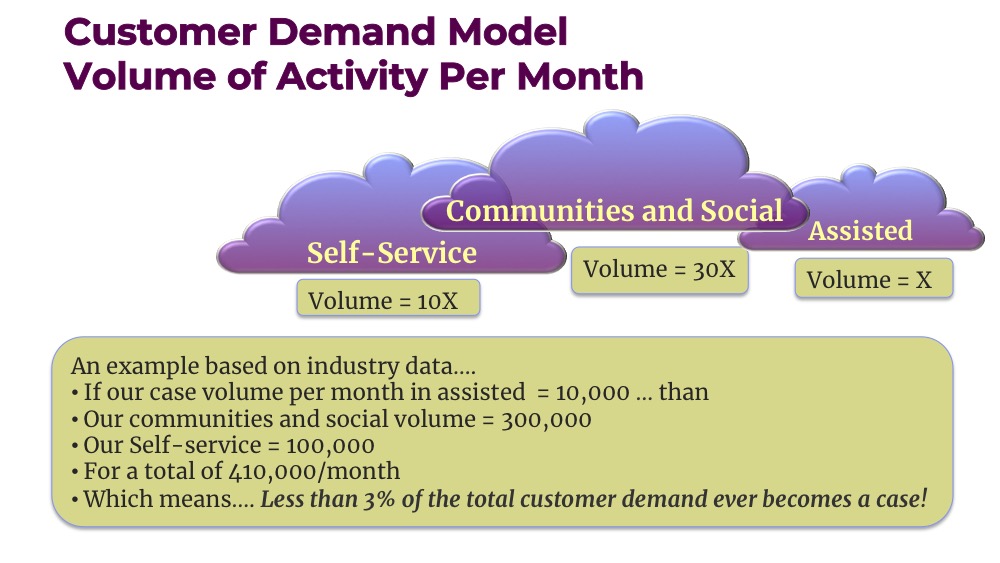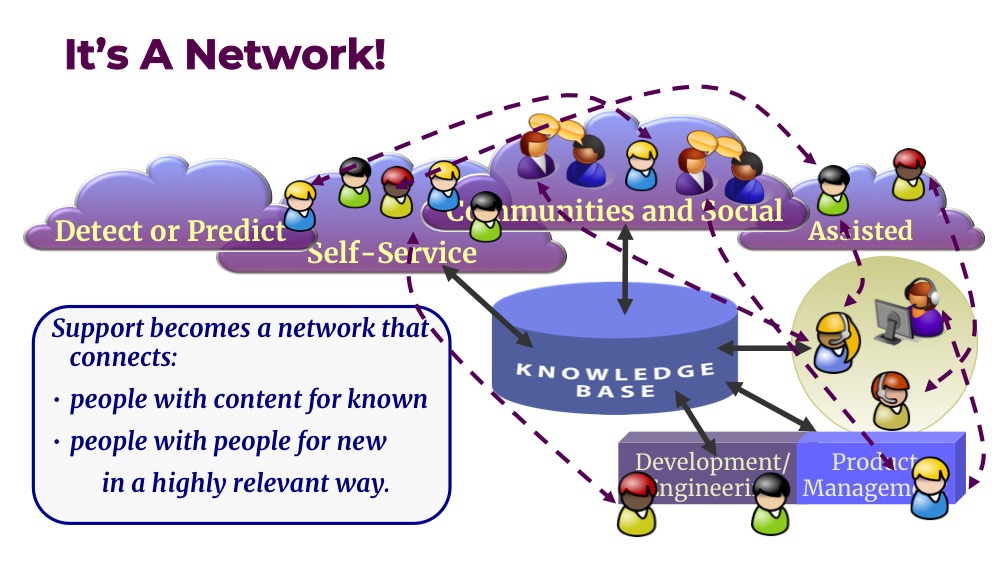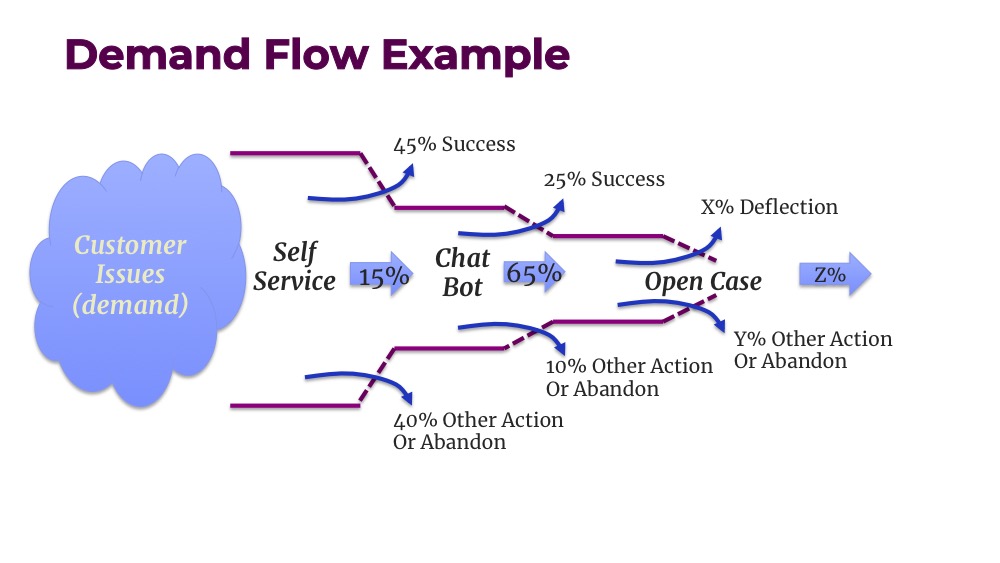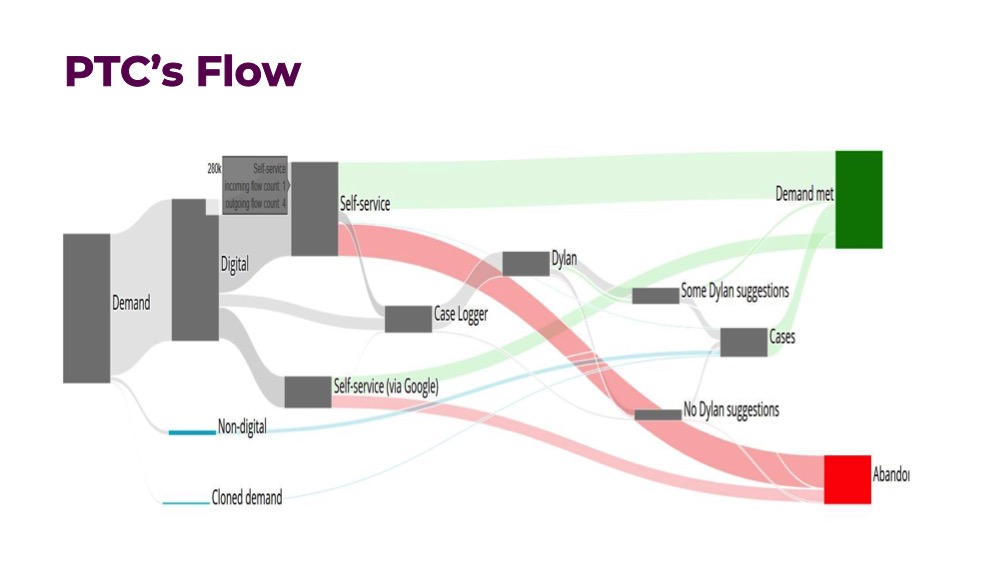Optimize and Innovate
Expanding our Measures Beyond our Organizational Boundaries
As our KCS adoption continues to mature, once again we must expand the scope of our measurement model. The Optimize and Innovate phase focuses on:
- Understanding total customer demand for support
- Optimizing the support network (beyond our organizational boundaries)
- Understanding the flow - the customers' experience
- Improving our ability to solve new issues (as the new vs known ratio shifts to more new)
Optimizing the Support Network
At this point on KCS journey, we are thinking about support as an unbounded network of people and content. We want to understand our customers' experience in dealing with the issues they encounter, most of which will never be reported as an incident or case. Our goal is to maximize the network for customer success.
The network is defined by all the ways a customer will pursue a resolution to an issue. The network includes support channels like communities, self-service, and the assisted support model. We want to connect people to content for known issues and people to people for new issues, with increasing speed and relevance over time. In order to optimize this network, we have to embrace a broader and more complicated set of metrics.
As we look to optimize the network to better serve our customer needs we learn from the activity in the network. As we discussed in the introduction, the opportunity is two-fold. On one hand, we want to minimize value erosion. On the other hand, a network view of customer engagement gives us a more complete and timely perspective on the customer experience, enabling us to identify opportunities to pursue value-add activities.
Customer Demand Model
To understand how to optimize the support network, we have to understand all the customers’ activity in pursuing a resolution. A network view of support can be very enlightening. Data from Consortium Members indicates that less than 3% of the customer activity in pursuing a resolution is represented in the assisted model (opening a case or incident). 97% of the customer activity is in communities, social networks, and with self-service mechanisms.

The first step is to understand the total customer demand for support and then understand the activity in each channel. To the extent we can, it is interesting to know how much of that activity is related to known issues vs new issues. Emerging patterns will often show up in communities and social channels before they show up in the assisted model. It is also helpful to understand the nature of the issues being pursued in each channel. Is the channel being used the optimal one for that type of issue? Are there things we can do to get customers into the best channel based on the type of issue?

We want to continuously improve our ability to connect people with knowledge for known issues and connect people to people to collaborate on solving new issues. An important factor in optimizing this network is leveraging the emerging digital automation capabilities. The opportunities to apply digital automation, like auto-classification, pattern recognition, recommendation or prediction engines, and optimization models are based on having good data.
By optimizing the network we reduce customer effort in finding resolutions to their issues. We must also focus on reducing customer effort in implementing resolutions, and most importantly, quickly identify pervasive and high-impact issues that are disrupting our customers’ success and productivity. This enables us to conduct root cause analysis and take corrective actions to remove the cause of those issues from the environment. This not only improves our customers’ experience but also resolves cost drivers of support.
Vocabulary is Important
Focusing on support as a network is a customer engagement strategy. Sadly, the industry has adopted a vocabulary that has no place in customer service and support. It is an unenlightened view of service and support that uses the words "avoidance" and "deflection" when talking about customer engagement and interaction. Cost avoidance is fine, as long as we are not optimizing our process at the expense of the customer, i.e. transferring cost or work from us to the customer. Our goal is cost savings in the context of reducing customer effort and optimizing our customers’ success and productivity in whatever channel the customer chooses to pursue a resolution.
Understanding Flow
Another measurement model that can help us understand and improve customer success is the flow or journey model. There are a number of customer journeys we can map. Each organization will have to map the flow they have enabled for their customers. Below is a simple example of a customer journey. It is interesting to measure the success rate at each step along the journey: the rate at which customers move to the next step in the journey as well as the rate of abandoning the journey.

Collecting the data for the customer activity, results, and experience in the support network is not trivial. However, the Consortium Member company, PTC, is collecting the data. They use a tool called Plotly to create the visualization for the demand flow. Here is an example of this kind of view.

Implications of “Mostly New”
One of the key goals of KCS is to solve an issue once and use it often. As we have mentioned, customer success with self-service and our influence with the owners and developers of our products, services, processes, and policies should result in a shift in the ratio of new to known incidents. As the support organization’s work shifts to mostly new, inevitably the traditional tiered support model becomes ineffective. Solving a new issue is fundamentally a collaborative process and the old escalation model - moving incidents from level 1 to level 2 and so on - is ineffective for solving new issues. We need to rethink how we align people with work. The emerging collaboration model is called Intelligent Swarming℠. The measures for swarming are focused on assessing the health and effectiveness of collaboration. This is a new way to look at the organization and is an area of research and innovation currently underway for several Consortium Member companies.
The Ultimate Measurement Model
A group of Consortium Members are actively working to develop a customer engagement measurement framework, and has published Understanding Success by Channel, which offers us a very broad view of customer activity, and how we might leverage knowledge to fulfill that demand.
Optimization Indicators
See Optimization Indicators in the Indicators of Transformation table.
